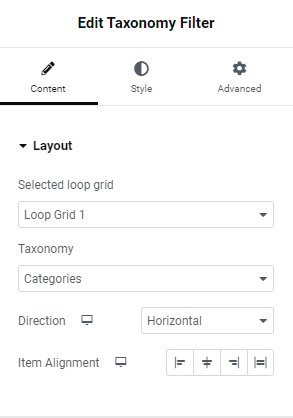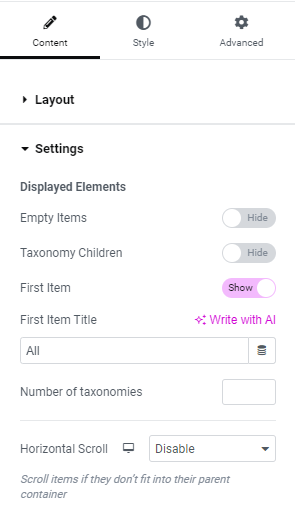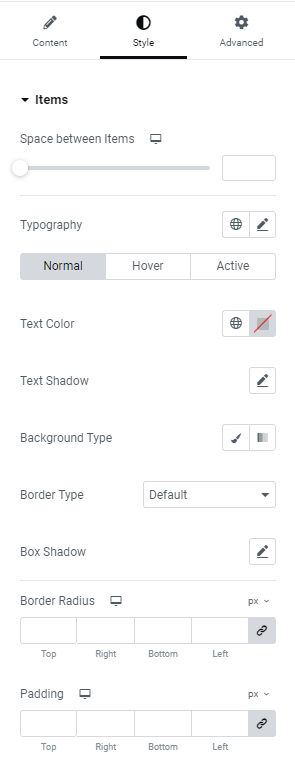The Taxonomy widget gives you a powerful way to control the items appearing in a Loop Grid, filtering them by categories and tags. This increases website usability and visitor engagement.
Prerequisites:
- The Taxonomy widget is currently an experimental feature, therefore you must activate it. To activate it, see Elementor experiments.
- The Taxonomy widget can only be used as part of a Loop Grid. Therefore, in order to use the Taxonomy widget, make sure the Loop Grid is active:
Create a Taxonomy filter
You can add more than one Taxonomy Filter widget to a Loop Grid, allowing visitors to filter by multiple characteristics (For example, all posts categorized as How-to with the tag of Important.
To create a taxonomy filter:
- Create a Loop Grid. For more details, see Build a Loop Grid.
- Add the Taxonomy widget to the Loop Grid. For more details, see Add elements to a page.

- In the panel, under the Contents tab, expand Layout.
- From the Selected Loop Grid dropdown menu, select the Loop Grid you want to filter.

- From the Taxonomy dropdown menu, filter by category or tags. A menu of categories or tabs appears in your Loop Grid.

When visitors click on a category or tag in the menu, only posts related to that category or tag will be shown in the Loop Grid. After filtering, they can click All to see all posts again. For example, if they want to see only Funky posts, they can click on Funky. To see all posts again, they should click All.
Taxonomy filter settings
Control and style how you filter the items in the Loop Grid.
Content tab - Layout
Choose which Loop Grid to filter, and what options are used for filtering.
Go to the Content tab, and expand the Layout section.

Select which Loop Grid you are filtering.
Choose between filtering by category or tag.
Which direction the taxonomy menu appears: horizontally or vertically.
Choose the position for the taxonomy menu:
- Start – Appears at the beginning of the Loop Grid
- Center -Appears in the middle of the Loop Grid
- End – Appears at the end of the Loop Grid
- Stretch – Appears along the length of the Loop Grid
Content tab - Settings
Control what appears in the Taxonomy menu.
Go to the Content tab, and expand the Settings section.

Define what appears in the taxonomy menu.
Toggle to Show or Hide categories/tags. If you select Hide, if no items have the filtered classification it will not appear. , For example, the category Funky will not appear if no posts are categorized as Funky.
Toggle to Show or Hide to display subcategories in the taxonomy menu.
After filtering, a new menu item, All appears. This is known as the First Item. Click this to see all posts again.
Toggle to Show or Hide the First Item
By default, the name of the first item is All. In the text box, you can change the name of the first item.
Limit the number of taxonomy items shown in the menu by entering a number in the text box. For example, entering 4 will display 4 out of the 25 items.
This setting determines how the screen handles an excess of taxonomy items. For example, if there are 25 categories, they will either wrap and appear on the next line or only be available by scrolling horizontally.
- Disable: This forces items to wrap to the next line.
- Enable: Visitors will need to scroll horizontally to see all items.
Style tab - Items
Control the appearance of items in the taxonomy menu by clicking the Style tab. Go to the Style tab, and expand the Items section.

Use the slider to set the distance between the text in the taxonomy menu.
Determine the font of the text in the taxonomy menu. For more details, see typography.
Configure how taxonomy text appears according to its state:
- Normal – default state
- Hover – when moused over
- Active– when selected
Select a state, and define the text color, shadow, background type, border type, and box shadow for that state.
Determine the color of the text in the taxonomy menu. For more details, see Choose a color or Use global fonts and colors.
Give the text in the taxonomy menu more depth by adding shadow. For more details, see What is Shadow?
Create a background for the taxonomy menu. For more details, see Create a Background.
Add a border to the taxonomy menu. For more details, see Border type.
Give the space surrounding menu items depth by adding shadow. For more details, see What is Shadow?
Round the corners of the border. For more details, see Border radius tools.
Add or subtract space around the taxonomy menu. For more details, see Padding and margins.
